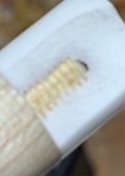Anybody think the ferrule might of had stress cracks from threading, and it failed at the bottom where it meets the shaft.
That was actually my first thought.
There are several variables.
Materials
Methods
Use
More
Always start at the beginning.
I have been watching this thread and thinking.
The stresses built in during assembly is one of the first considerations.
The void is an obvious contributing factor as well.
All very interesting.
The way I see it there are two main stressors in assembly. Those that tend to hold things together, and those that tend to push things apart. Compression vs separation?
I am just observing. Can't claim to have assembly experience. But I do think all variables should be considered.
My experience is more in engine assembly, metal. How the threaded part is seated introduces stress. The threads can be perfect. But the final seating can introduce stress that can cause failure.
.

